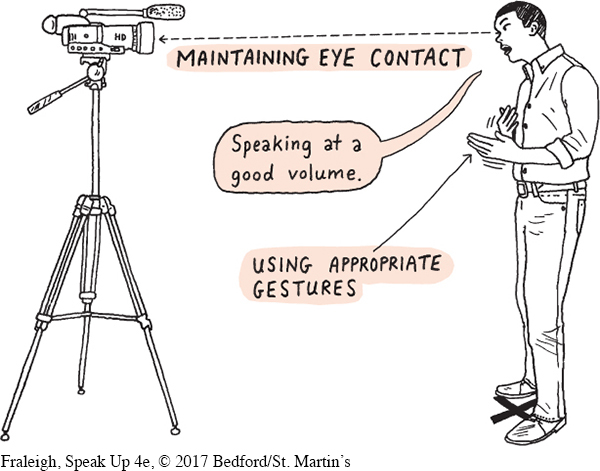Delivery Considerations
First, let’s discuss some considerations for delivery. These points apply to both prerecorded and real-
Voice. To make sure your speaking voice is effective in a mediated presentation, a good general rule is to speak at about the same volume you would use to address people seated in a conference room. If you are prerecording, consider doing a quick “voice check”: record yourself saying the beginning of your introduction, and play it back to ensure appropriate volume.
Maintaining an effective rate of delivery can be a challenge. There is a natural tendency to speed up your presentation if no audience is present, and the absence of an audience means you will not receive feedback if you speak too fast. To keep your rate under control, be sure to pause at natural stopping points in your speech.27 For example, you might pause before you transition to the next main point, after you display a visual aid, or after you present evidence. Recall that speaking to a camera rather than a roomful of people can make it seem as though you are communicating with a vast empty space, which can cause you to lose energy. Imagine that you are speaking to a live audience, and consciously try to maintain an energetic delivery. Include some reminders on your extemporaneous notes, such as “Energy!” or “Enthusiasm!”
Page 449
If your audience is watching you from different locations (say, for an online class), consider asking them to use high-
Eye Contact. Maintaining eye contact with your listeners is a challenge in mediated presentations because you can’t look at them directly. (Even in real-

Page 450
Movement and Gestures. Elements of nonverbal delivery such as movement and gestures are also affected in a mediated presentation. On a screen, your gestures will appear more prominent because you are being displayed in a smaller area. Expansive gestures may also move out of the frame of your video. (Even if you have a skilled cameraperson, she or he can’t anticipate your natural, conversational gestures.) It is important to gesture when you are recording a speech, but be careful not to gesture too expansively.29
Movement also needs to be controlled. Ensure that all movement remains within the range of the camera so that you do not move in and out of the screen. If your camera cannot move because you are recording your own speech or speaking at a fixed microphone, you may need to speak from a fixed location. If this is the case and you can’t use nonverbal cues (such as pointing to an item on a visual aid or moving to indicate a transition), be sure to provide clear verbal cues to help audience members understand your point.